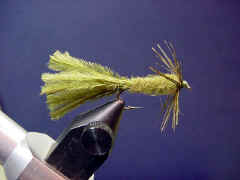|
Fly of the Month Bob Ireton brings together his experience in fly fishing, aquatic entomology, and knowledge of fly tying techniques and materials, to design and tie durable and effective flies. |

|
![]()
Volume 4, Issue 3
March 2003
![]()
MURRAY'S STRYMPH
Fly and Text by Bob Ireton
Photography by Bob Kimsey and Bob Ireton
This pattern was developed by Harry Murray, owner of
Murray's Fly Shop in Edinburg, Virginia, to fish for smallmouth bass in
the Shenandoah River. Harry came up with the name 'strymph' because this
fly can be fished as a streamer to imitate minnows, or fished as a nymph
to imitate aquatic insects. Once it is wet, a strymph becomes a slender,
slinky lure. The entire dressing, even the rabbit fur body, wriggles or
pulsates as you swim the fly.
Although this pattern was originally developed by
Harry Murray to fish for smallmouth bass in the Shenandoah river, fly
fishermen across the country have found the strymph to be a first rate fly
for trout. I think this fly will catch almost any fish.
MATERIALS
Hook - TMC5262, Mustad 9672, Dai-Riki 710, Daiichi 1720, Orvis 1526, Partridge SH3
Size 2-10
Thread - 6/0 Olive
Weight - Lead Wire
Tail - Olive Ostrich Herl
Body - Olive Dyed Rabbit Fur
Collar - Olive Dyed Speckled Indian Hen Saddle
TYING STEPS
![]()
Copyright © 1998 - thisyear The Buckeye United Fly Fishers, Inc. Cincinnati, OH 45242
The Buckeye United Fly Fishers, Inc is a non-profit corporation organized under section 501(c)(3) of the Internal Revenue Code, incorporated in the State of Ohio for the preservation, conservation and wise use of our fishing waters and game fish; and to assist in the protection and improvement of our natural resources





